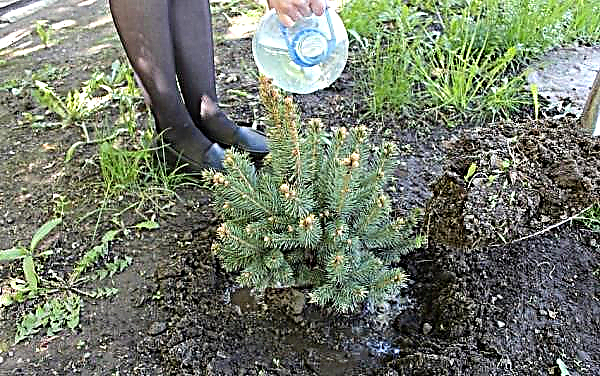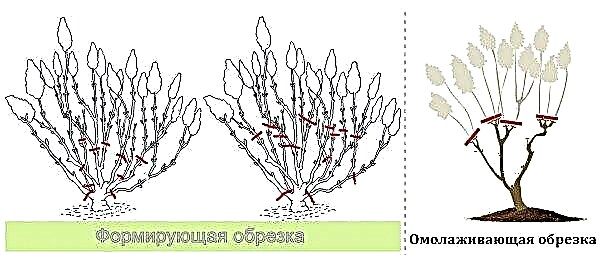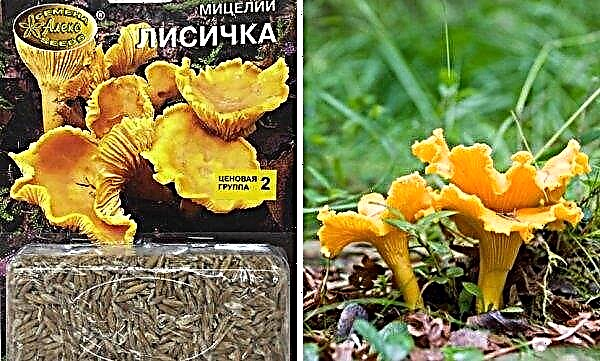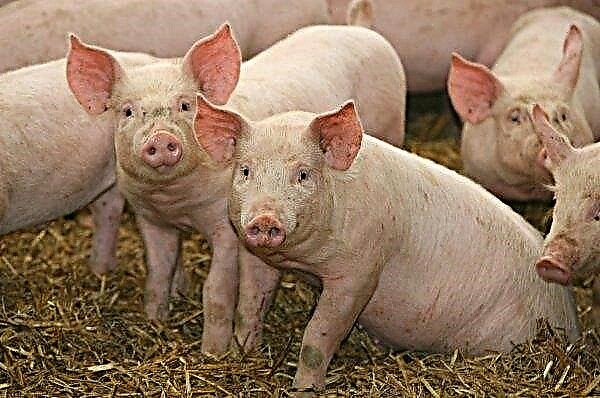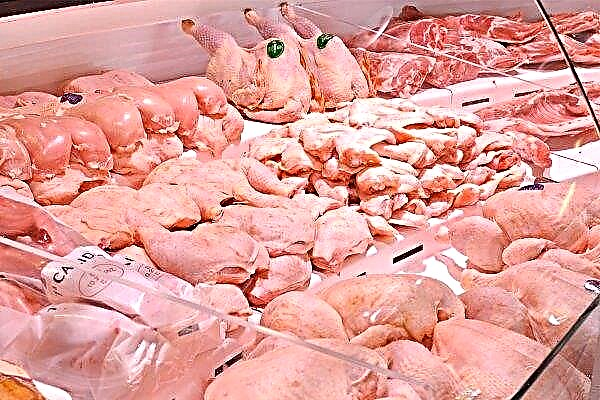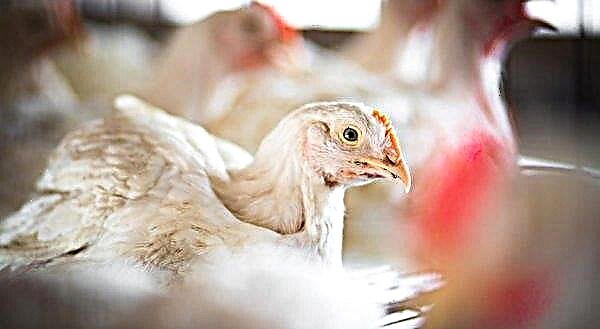Sugar beets are mainly cultivated by large agricultural enterprises, which then process it and get sugar. However, often farmers and ordinary gardeners successfully grow this interesting and useful plant in their gardens. What kind of root crop is it and how to grow it is described in this article.
Botanical Description
This species from the amaranth family is one of the relatives of ordinary beets, only with a high content of sucrose in the pulp. The plant is two-year-old: in the first year a long root and a developed rosette of leaves are formed, then there is an increase in the mass of the root.
In the second year, flower-bearing stems appear. The species is subject to deviation from the two-year life cycle - it can grow the stem in the first year (in the people it is called "go to color", or flowering).
Did you know? In contrast to flowering, at warm temperatures during the growing season, some bushes in the second year of life do not produce flower-bearing stems. Such plants are called "stubborn."
The root system is not limited to a powerful rod main root - lateral roots extend to a considerable distance from it, sometimes up to 50 cm. The main root is conical, flattened on the sides and includes such departments (from top to bottom):
The main root is conical, flattened on the sides and includes such departments (from top to bottom):
- head - leaves grow from it;
- neck - without shoots and roots;
- root - fleshy formation with numerous lateral processes.
Flower-bearing leaves can grow up to 1.5 m, forming in the sinuses flowers with 1 pestle and 5 stamens. Together, they form a kind of spike that forms at different heights. It is called the "loose ear".
The species is cross-pollinated; its pollen can be carried both by wind and by insects. Flowering lasts up to 40 days, which is enough for high-quality pollination. Seeds resemble small shapeless nuts and are formed from several flowers - from 2 to 6.
The history of cultivation and cultivation in the world
The German chemist Andreas Marggraf in the distant 1747 found out that beets contain a large amount of sugar, which until now in the world was obtained only from sugar cane. At that time, the amount of sugar in root crops was up to 1.3%. Prolonged selection has led to the fact that modern species already contain up to 20% sugar.
The first sugar beet processing factory was built in 1801 in Lower Silesia in what is now Germany. In Russia, the first such factories appeared in the first half of the 19th century under the auspices of the grandson of Catherine II Count Bobrinsky.
Biological features
Despite the seeming usualness, sugar beets have their own vagaries to the conditions of cultivation. It is especially demanding on temperature conditions. The full development of the plant occurs when the sum of the active temperatures from 2200 to 2700 ° C is reached.
This indicator characterizes the excess of the total heat for a specific period above a certain threshold, which affects the development of the plant. Normal temperatures for the proper growth of sugar beets are:
Normal temperatures for the proper growth of sugar beets are:
- early germination - 2–7 ° С;
- optimal germination - 12–15 ° С;
- growth and quality development - 22–25 ° С.
This plant loves long daylight hours, which allows it to grow well and increases the sugar content in tissues. The growth and maturation period in each year of life varies: in the first year it is up to 170 days, and in the second - up to 130.
The first year of growth can be divided into 3 stages:
- assimilation of plant roots and soil - 1.5 months;
- the main growth of the root system and foliage is 2-3 months;
- active accumulation of sugar is the last month of development.
Important! The plant develops better and faster in neutral chernozems, and loams with a mechanical composition are also not bad. It is not necessary to plant a culture in clay soils and sandy loam.
The plant is unique in that it has the so-called molt of the root, which occurs when the first 2 true leaves appear. The bark at the root is cracked and discarded, and in its place a new one grows. Before the start of this process, it is necessary to carry out manual thinning, leaving the most viable specimens.
Varieties and hybrids
In an effort to isolate varieties or hybrids with the best characteristics, breeders have bred many different types of sugar beets, which vary in size and quality of root crops. Also taken into account indicators of productivity and sugar content. The sweetest varieties with sugar content (sugar yield from the fruit mass) above 20% have a low yield. Conversely, harvested species show a reduced sugar content - about 16-17%.
Also taken into account indicators of productivity and sugar content. The sweetest varieties with sugar content (sugar yield from the fruit mass) above 20% have a low yield. Conversely, harvested species show a reduced sugar content - about 16-17%.
Not all farmers grow crops to extract sugar from it - it is also very popular in cattle feeding. In this case, the sugar content is secondary, and the yield of the variety and the mass of root crops come to the fore. At the same time, appearance (form, lack of hollow) and sugar content itself become secondary factors.
The main types that are popular on farms:
- Araxia. This German hybrid has a high yield - up to 800 centners per hectare. Sugar content is about 16.5%. In root crops, hollows are practically not formed.
- Big Ban. Another German variety with slightly lower yields is 700–720 centners per hectare. The sugar content in them is average - about 17.5%, but the beets do not appear hollow in the pulp.
- Bohemia. Large and sweet root crops weighing up to 2 kg, sugar content - 19%. However, they have significantly lower productivity - up to 300 centners per hectare. The variety is distinguished by good shelf life and is suitable for long storage.
- Bona. Small beets (up to 0.3 kg), which gives a small crop - 100 centners per hectare. But the value of this variety is its resistance to drought, atypical of other representatives of the species. These ripening fruits contain very little sugar - up to 12%, which allows them to be used as fodder.
Important! It is quite difficult to independently prepare sugar beet seeds. It is better to simply purchase seed in specialized stores or procurement farms.
Properties, Significance and Application
Despite the fact that sugar beets are little used in their unprocessed form, this plant is of great importance for the national economy and the prevention of diseases in both humans and domestic animals. It contains such useful substances:
It contains such useful substances:
- sucrose;
- trace elements - iron, magnesium, iodine;
- vitamins of different groups - B, C, PP (nicotinic acid).
These root crops are used not only for sugar production. They are used in household and farm households to feed livestock and poultry, as an ingredient in culinary dishes (for baking or in salads), as an element of traditional medicine potions.
In the latter case, it is worth noting that the sugar content in this plant makes it contraindicated for people with diabetes.
Growing Basics
The plant has its own “preferences” at different stages of cultivation. Demanding for soil and care somewhat distinguishes sugar from food types of beets.
Soil requirements
The best soil for growing sugar beets is chernozem. However, the use of such a land rich in microelements for the cultivation of industrial crops is not always justified. If possible, it is better to use more “simple” soils, such as sierozems, drained peatlands.
Clay or sandy soil types are contraindicated - in them root crops weakly develop, grow small and not sugary enough.
The soil structure is optimal for cultivation with the presence of a water-retaining layer (loam, clay, sand) under fertile soil at a depth of 0.6–0.8 m. If the layer is smaller, then the roots will turn out to be damp and begin to rot, and with a larger layer, drying and growth retardation is possible.
If the layer is smaller, then the roots will turn out to be damp and begin to rot, and with a larger layer, drying and growth retardation is possible.
Did you know? The largest sugar beet grew in 2001 in the English county of Sommerset. The mass of the giant was 23.4 kg.
Predecessors
When choosing a place for planting sugar beet seeds, it is important to consider which plants were grown on this site last year. Not all cultures are desirable precursors, and some, on the contrary, are very suitable for the subsequent planting of the described culture.
Do not plant this beet after growing such crops:
- amaranth family - other types of beets, spinach, chard;
- cruciferous family (cabbage) - cabbage, fodder cabbage, kohlrabi, rutabaga, radish, turnip, salad, mustard, rape, rape, raspberry, saffron milk cap;
- bean family - beans, beans, peas, soy.
Such a complex and unusual list of exceptions is due to the fact that all of these families are subject to the same pests, which next year in the same area can hit a sugar beet plantation.
And here are a few plants, after which beets will feel good:
- potatoes (if weeded well from weeds);
- family of cereals - wheat, barley, rye, oats;
- spices.
In small farms (small farm, summer cottage, garden) it makes sense to alternate beets (and not only sugar) with potatoes on the same site every year - for plants, these are mutually beneficial conditions for growing.
Sowing
Preparation for sowing begins in the fall, when the earth is dug up to a depth of 20 cm and fertilized. Fertilizer is introduced as follows: potash-phosphorus (2 kg per hundredth) and manure (35 kg per hundredth). In the spring, nitrogen fertilizers are applied (up to 1 kg per one hundred square meters), the site for this needs to be leveled so that moisture does not accumulate in its individual parts.
During planting a few centimeters deeper than the seeds, superphosphate (0.2 kg per hundred square meters) should be laid, which will stimulate the growth of growing roots.
Before sowing seeds, it is necessary to measure the temperature of the soil. When at a depth of 5 cm it reaches 6–8 ° С - the landing time ends. A couple of hours before planting, the seeds must be soaked in a solution of wood ash. This procedure will significantly enhance the growth of future shoots.
Seeds are laid to a depth of 2-4 cm in the prepared bed. You can mix them with sand and gently pour this mixture into the groove, avoiding the accumulation of several seeds in a small area. At the end of the planting, the bed is covered with earth so that there is a small shaft above it. The distance between the beds is 45-50 cm.
Care
When shoots appear and grow, 2 thinning is carried out: first, the sprouts are left at a distance of up to 6 cm, and then up to 18 cm. The plant responds well to watering immediately after laying the seeds. When foliage appears, it is better to water with a small drop top watering (imitation of rain). Although sometimes rain is enough for watering.
Weeding is carried out manually - despite all the complexity and laboriousness, it is much more effective and more useful than the use of herbicides.
However, it’s almost impossible to weed large fields, so here they still use chemicals that are sprayed in the morning or evening in certain weather: soil and air temperature - 15–25 ° C, no wind, no forecast precipitation for the next 6 hours.
Diseases and Pests
Diseases and pests of sugar beets can take a significant part of the crop, so it is important to identify and overcome them in time.
Among the diseases, the most common are:
- alternariosis;
- root eater;
- formosis (zonal spotting);
- brown rot;
- black rot;
- Fusarium rot;
- root vegetable scab;
- powdery mildew;
- ramulariosis;
- cercosporosis.
 Pests of sugar beets are such subspecies of insects related to the enemies of beet crops:
Pests of sugar beets are such subspecies of insects related to the enemies of beet crops:- aphid;
- bug;
- weevils - common, gray, black;
- flea;
- shieldonosk;
- baby
- mining moth;
- beet flies - light and dark.
- nematode.
In pest control, the following methods are used:
- getting rid of weeds that grew under the predecessors;
- low mowing of weeds of the legume, haze, cabbage family, which contribute to the development of harmful insects;
- high-quality agricultural technology;
- timely application of the required quantities of potash and phosphorus fertilizers;
- row-spacing loosening;
- mixing fertilizers from last year's beet waste with lime in a ratio of 4 to 1;
- during the growing season, the bushes are sprayed with Fitoverm (insecticide) and Fitosporin (fungicide), which are environmentally friendly and well help in the fight against nematodes and beet aphids.
To prevent plants from getting sick, preventive measures must be taken.
Significantly reduce the risk of damage to the bushes by the most common diseases will help to perform a number of simple procedures:
- Autumn digging of the earth;
- regular inspection of crops during their growth;
- watering with warm water warmed up in the pipes during the day.

Harvesting
Sugar beets are harvested in the last decade of September. These root crops are very brittle, therefore, they must be removed from the soil carefully because of their considerable length.
If the beets are immediately sent for processing, its damage is not too critical (although this will slightly reduce the volume of the crop), but for storage you need to choose only whole quality specimens.
Store the crop in vegetable stores at a temperature of 0 to 3 ° C. If there is no specialized room, then vegetables can be poured into piles or trenches, covering them with layers of earth, straw, sawdust, as well as snow.
The main use of sugar beets is the manufacture of sugar. The plant is also valued in medicine and is useful for feeding pets. In addition, small slices of root crops with high sugar content can be used in cooking. With the right approach to growing this type of beet, you can get good yields and significant profits.

